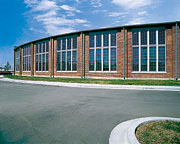
Today, the renovated structure provides 60,000 sq ft of air conditioned office space for DST Output, provider of paper and electronic statements and other documents to companies in the communications and financial industries. A new 230,000-sq-ft building constructed on property adjacent to the roundhouse is home to the company's printing operations. Together, these buildings comprise the Westside Business Park.
While not part of the original structure, air conditioning needed to be incorporated into the design of the renovated facility. The challenge for architect James Pastine of International Architects Atelier, and mechanical contractor Bill Fagan, executive vice president for The Fagan Company, was to introduce an HVAC system that provided comfort cooling even as it preserved the aesthetics of the building and adhered to the strict guidelines established by the U.S. Department of the Interior to protect properties listed in the National Register.
‘Completely Gutted'
According to Pastine, the roundhouse had to be completely gutted before new office space could be created. "We preserved the original brick walls," he explained, "and we salvaged a good bit of original railroad equipment that became part of the building design. The rest of the building was reconstructed using the original drawings from 1914."To satisfy the special requirements of the historic property, M C Real Estate Services, the construction project manager and property management firm, urged The Fagan Company to consider an HVAC system like one installed in another DST renovation. According to Fagan, "We installed a York FlexSys underfloor air system and York rooftop units as part of another DST project, and the owner was quite pleased. They asked us if the same system could be applied here, and it could. We ended up installing one York 25-ton Millennium rooftop unit and three York Eco2 rooftop units (one 50-ton and two 60-ton) that serve the FlexSys underfloor air system."
From an architectural point of view, the raised-floor HVAC system eliminated conventional overhead ductwork, freeing space for design purposes. "The underfloor system supported our restoration efforts by enabling us to preserve the 26-foot-high ceilings as well as the exposed heavy timber beams and columns of the original design," explained Pastine.
"Round buildings like this are not conducive to a grid of ceiling ductwork. By locating the air distribution system underfloor, we were able to run it wherever we needed it. That flexibility saved us a considerable amount of time and money during both the design and installation phases of the project.
"Finally, the historic nature of the building precluded us from putting anything on the roof. The underfloor system allows us to use ground-mounted air conditioning units that are easily and unobtrusively ducted into the floor plenum from the side of the building."
‘The Real Savings are in the Operation'
Fagan estimated the FlexSys underfloor system accelerated construction by as much as 10% to 15%, reducing renovation costs in the process. "But," he added, "the real cost savings are in the system's operation. The FlexSys system delivers 60° to 65°F air, versus 55° air associated with a conventional overhead system. As a result, outside air free cooling can be used more often, reducing operating costs and conserving energy."The FlexSys system also improves occupant comfort and air quality. Each terminal can be individually adjusted for 16 different airflow patterns for personalized comfort. And, because air is not blown from overhead, where pollutants congregate, the system provides improved IAQ.
To meet the underfloor system's temperature and humidity requirements, York provides a factory-supplied solution for the Eco2 rooftop units. The units feature double-wall construction, low kW consumption, compressor and fan energy savings, and full-sized rainhoods. Added Quentin McArthur, sales manager, McQueeny-Lock Co., "Eco2 units use HFC-407C, an environmentally friendly refrigerant that is not subject to regulatory phase-out."
For DST Output, the Eco2 rooftop units and the FlexSys underfloor air system have combined to produce a building with the look of the past and the flexibility of the future. "Flexibility is important today to accommodate the costs and disruptions caused by churn," explains Fagan. "Tenants change, companies reorganize, and as a result, people move. The underfloor system enables building owners to easily, quickly and inexpensively move or reorganize office space without tearing down or otherwise interfering with other mechanical systems."ES
